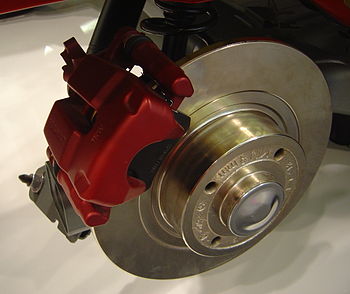Nowadays, all modern cars have brakes on all four wheels. The brakes may be disc type or drum type and is operated

by a hydraulic system. When braking, the car throws its weight forward on the front wheels, making front brakes play a greater part than the rear ones as far as stopping the car is concerned.
Generally, almost all cars have disc brakes at the front that is more efficient and drum brakes at the rear. Some expensive and high-performance cars used all-disc braking system, on the other hand, all-drum braking system are used by older or smaller cars.
What is a disc brake?
A DISC BRAKE turns with the wheel because of its disc. This disc is connected by a caliper that has small hydraulic pistons worked by pressure from the master cylinder. The pistons press on friction pads which clamps against the disc from each side making the car’s speed slow or stop. These pads cover a broad section of the disc. In dual-circuit brakes, pistons may come in single or more pairs.
There may be more than a single pair of pistons, especially in dual-circuit brakes. Rubber sealing rings around the pistons are designed for the tiny gap to remain constant and that the brakes need not to be adjusted as it let the pistons gradually slips forward. Most cars have wear sensors leads rooted in the brake pads. The leads are short-circuited by the metal disc and are exposed by a warning light on the instrument panel every time the pads are nearly worn out.
What is a drum brake?
A DRUM BRAKE turns with the wheel by a hollow drum. There are two curved shoes carrying friction linings in the stationary backplate covering drum brake’s open back. These shoes are forced by hydraulic pressure outwardly moving pistons in the cylinders of brake wheels, and then pressing the linings against the inside of the drum to slow or stop.
A pivot at one end and a piston on the other made up each brake shoe. When the rotation of the drum made contact, it tends to pull firmly the leading shoe resulting to good braking effect. Some drums have one leading and one trailing shoe, with pivot at the front while others have twin leading shoes where each has its own hydraulic cylinder.
What is hydraulic brake?
A HYDRAULIC BRAKE circuit has a slave cylinders connected by pipes and a fluid-filled master. When brake is applied, it dampens a piston in the master cylinder, which forces the fluid along the pipe. The fluid then travels to slave cylinders going to each wheel and fills them, forcing pistons out to apply brakes. The pressure in the fluid is distributed evenly around the system. The pushing area of all the slave pistons is much greater than the piston in the master cylinder.
This allows the brakes to exert great force. Consequently, many modern cars have twin hydraulic circuits together with two master cylinders in case the other fails to function. Furthermore, almost all cars now have load-sensitive pressure-limiting valve. This valve closes whenever hydraulic pressure rises to a certain level due to heavy braking which may cause the rear brakes to lock preventing any fluid movements.
Some cars may even have anti-lock systems that can sense in different ways like, if the car is slowing its speed or if any wheels are locking. This system make the brakes apply and release in rapid succession to stop them from locking.
If your car needs to be checked Dave Smith Motors can help you.